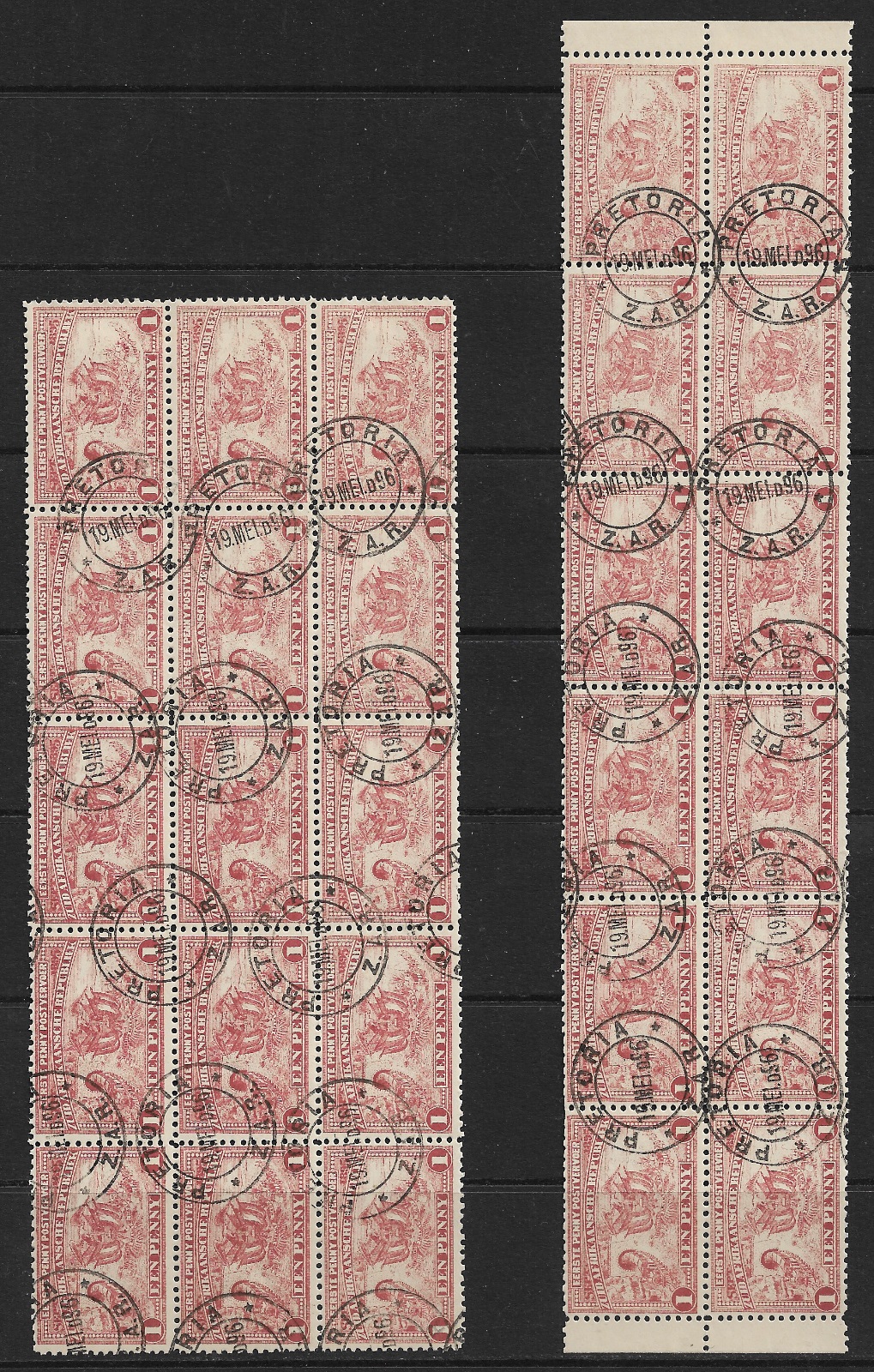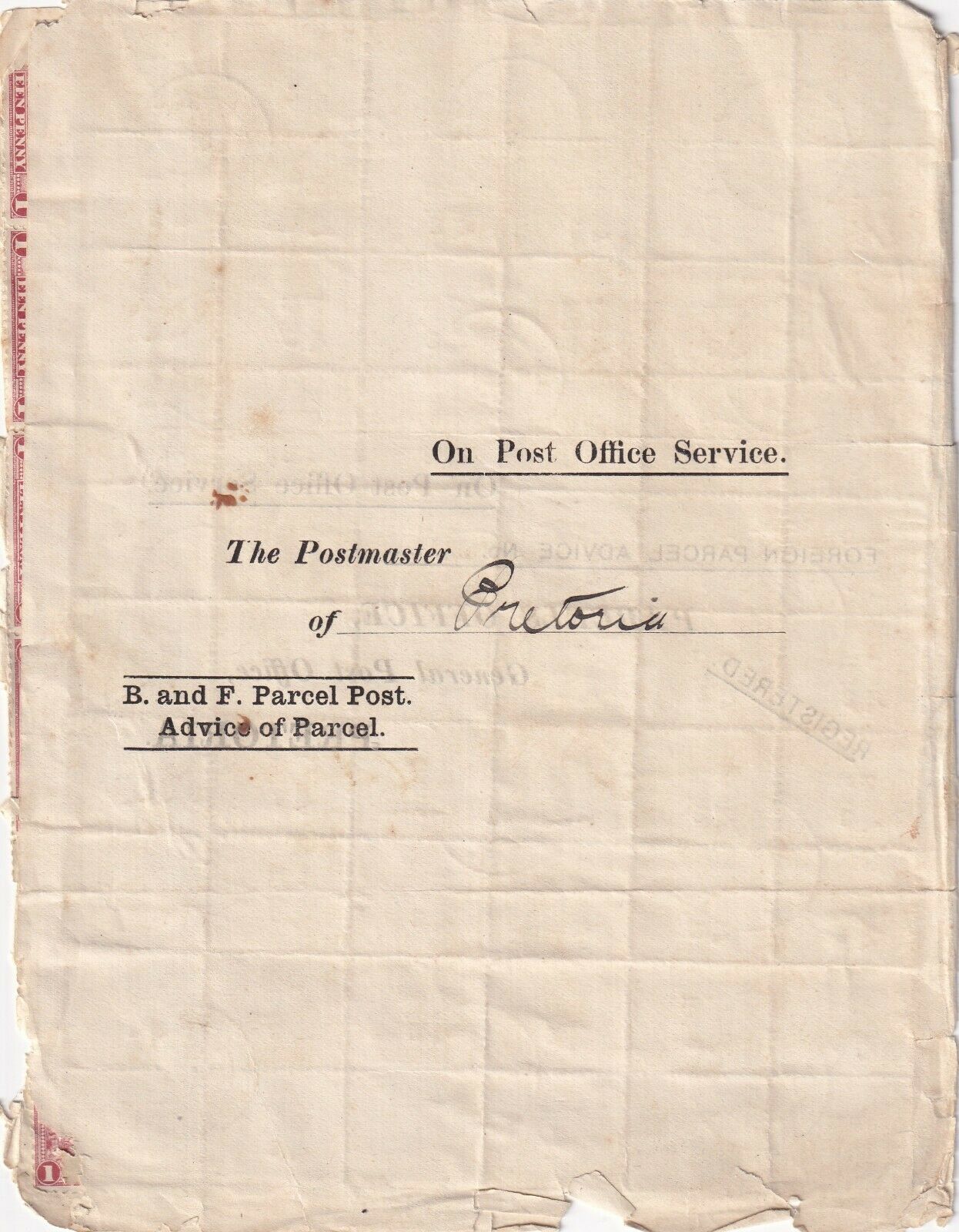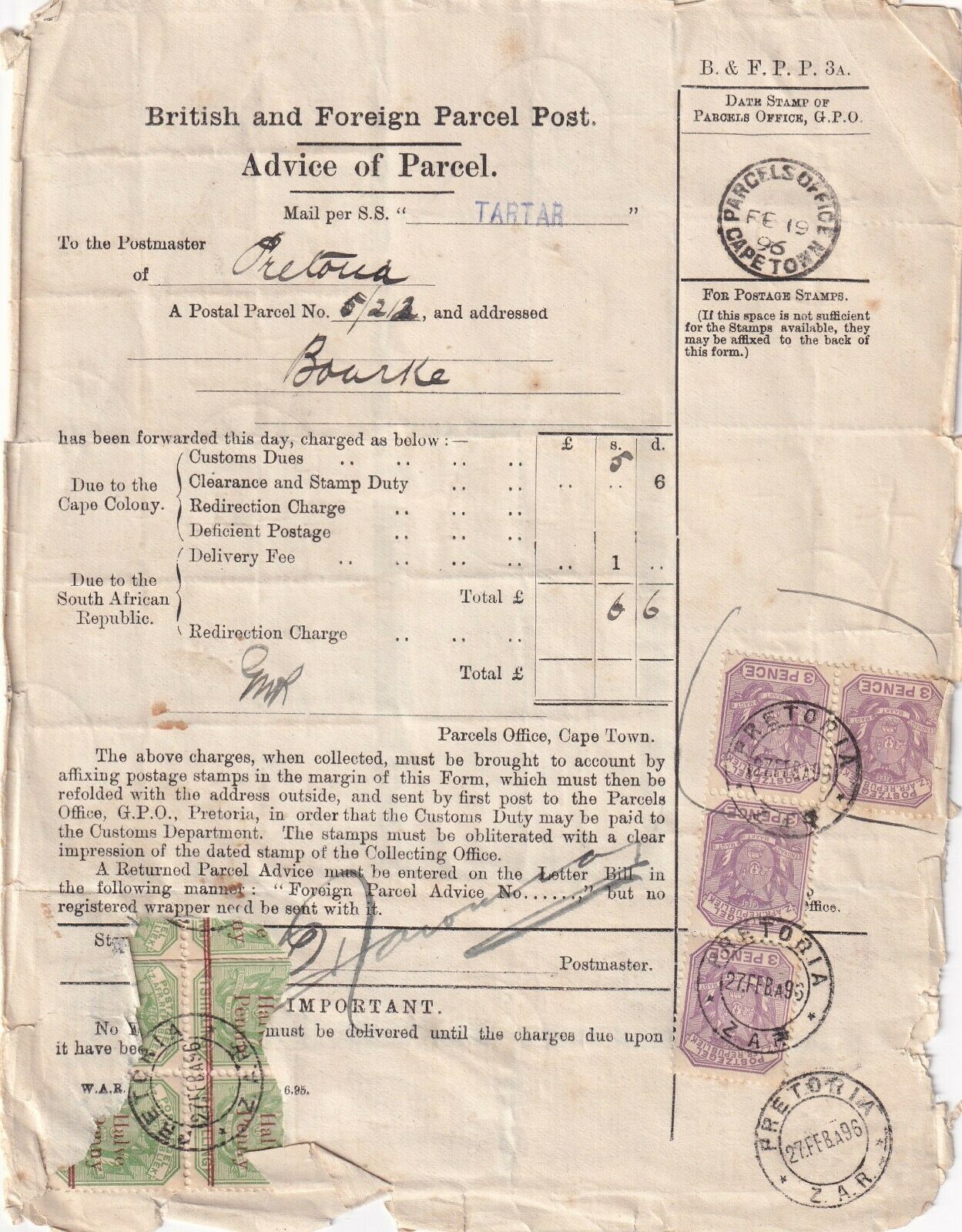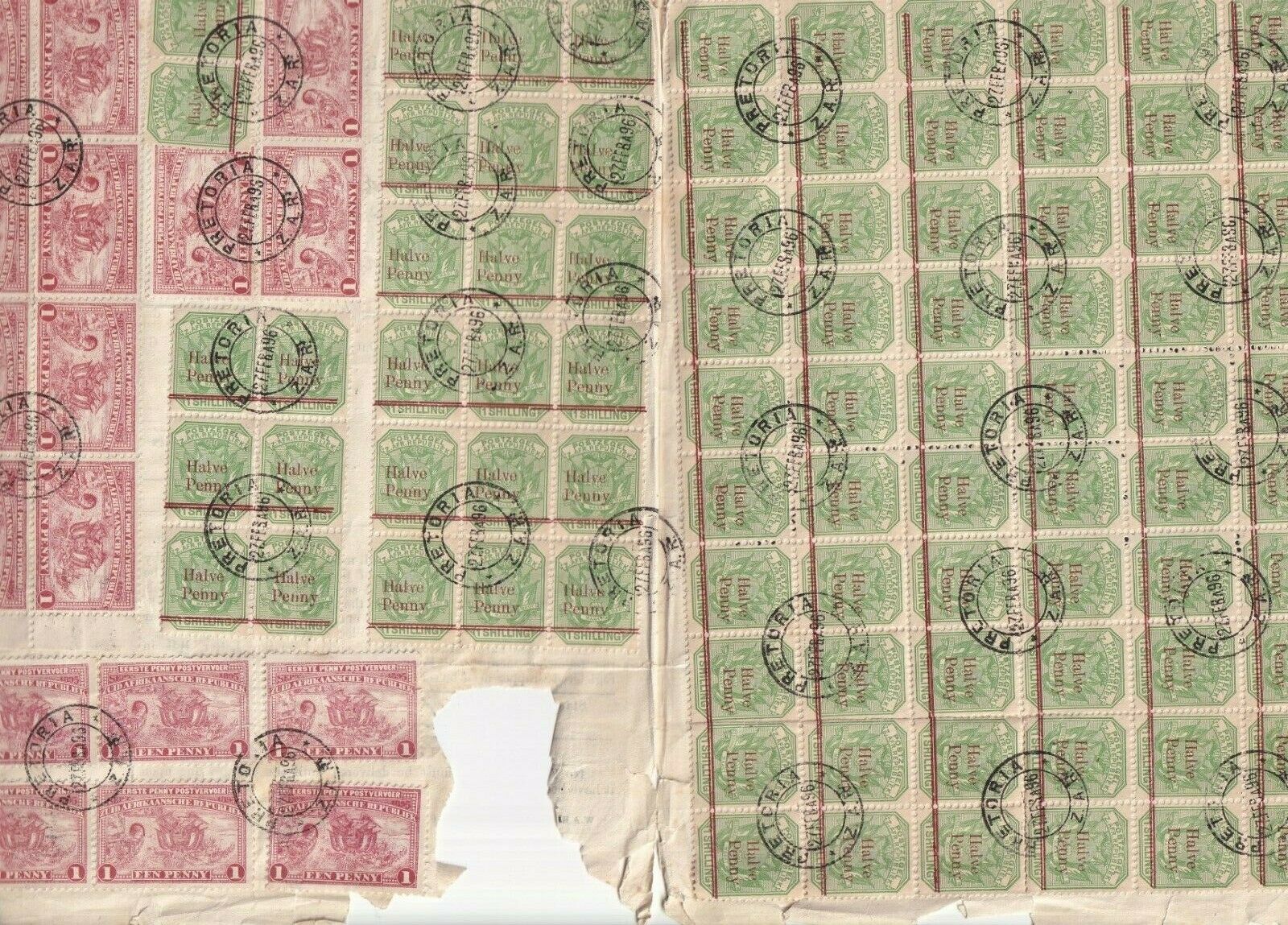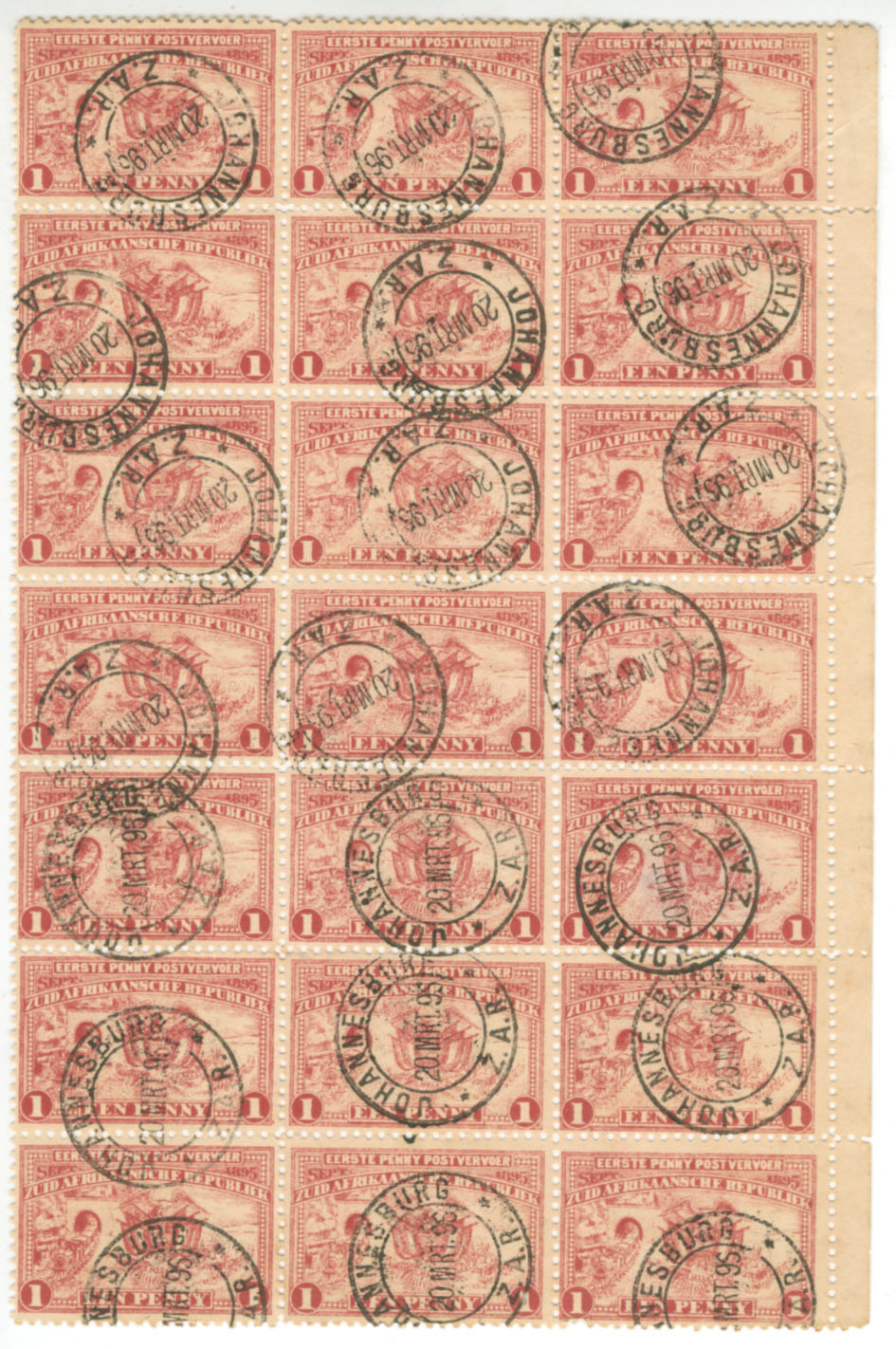Large used ZAR blocks: fake, CTO or genuine use?
Quote from Bas PAYNE on September 9, 2020, 3:03 pmI have just bought two large blocks of 1d 1895 ZAR commemoratives with Pretoria double circle date-stamps dated 19 MEI D96 (illustrated below); the backs are still gummed; and such blocks of used low-value ZAR stamps are not uncommon. The usual view is that they are either fake or cancelled-to-order.
But is this right? Another recent buy (also illustrated) is an 1896 Cape parcel form, sent to Pretoria for payment of customs and other charges, the back of which is covered with ZAR ½d and 1d stamps with Pretoria double-circle date-stamps dated 27 FEB A96, to a value of 6s 6d. I have seen other examples; they show clearly that low-value ZAR postage stamps were sometimes used fiscally in large blocks, and cancelled with ordinary postal cancellers, and add to other suggestions that higher-denomination stamps were sometimes in short supply in ZAR post offices, as evidenced, for instance, by registered covers with a number of 1d stamps stuck like overlapping tiles.
I'm not trying to suggest that all large postmarked blocks of ZAR blocks result from fiscal use; but it is an explanation that needs to be considered when the date-stamps look genuine, especially as there's no strong evidence that large blocks were cancelled to order - at that date ordinary used stamps wouldn't have been worth more than mint ones, so there wouldn't have been any incentive to get them cancelled to order in large numbers.
I would be grateful if fellow-members would let me have details of other large (i.e. a dozen or more stamps) cancelled blocks of ZAR stamps - it would be interesting to see what patterning emerges. The one I've seen so far with genuine-looking postmarks mostly have Pretoria and Johannesburg date-stamps in early 1896.
I have just bought two large blocks of 1d 1895 ZAR commemoratives with Pretoria double circle date-stamps dated 19 MEI D96 (illustrated below); the backs are still gummed; and such blocks of used low-value ZAR stamps are not uncommon. The usual view is that they are either fake or cancelled-to-order.
But is this right? Another recent buy (also illustrated) is an 1896 Cape parcel form, sent to Pretoria for payment of customs and other charges, the back of which is covered with ZAR ½d and 1d stamps with Pretoria double-circle date-stamps dated 27 FEB A96, to a value of 6s 6d. I have seen other examples; they show clearly that low-value ZAR postage stamps were sometimes used fiscally in large blocks, and cancelled with ordinary postal cancellers, and add to other suggestions that higher-denomination stamps were sometimes in short supply in ZAR post offices, as evidenced, for instance, by registered covers with a number of 1d stamps stuck like overlapping tiles.
I'm not trying to suggest that all large postmarked blocks of ZAR blocks result from fiscal use; but it is an explanation that needs to be considered when the date-stamps look genuine, especially as there's no strong evidence that large blocks were cancelled to order - at that date ordinary used stamps wouldn't have been worth more than mint ones, so there wouldn't have been any incentive to get them cancelled to order in large numbers.
I would be grateful if fellow-members would let me have details of other large (i.e. a dozen or more stamps) cancelled blocks of ZAR stamps - it would be interesting to see what patterning emerges. The one I've seen so far with genuine-looking postmarks mostly have Pretoria and Johannesburg date-stamps in early 1896.
Uploaded files:Quote from Steve on September 10, 2020, 9:49 amThis is an interesting suggestion that ZAR postage stamps were possibly used in the absence of ZAR fiscals. I have several blocks of the 1895 ZAR 1d red Arms and Train, all with no gum. They all came out from the same auction lot. The postmark is the same throughout, JOHANNESBURG ZAR with two Stars separating town and state ie. the same type as the PRETORIA example shown above by Bas. Starting with the largest, they are:
2 x Block x 21 (42) - JOHANNESBURG ZAR 20 MRT 96 (one block of 42 previously joined, now separated)
One block of 21 shown below.
Block x 8 - JOHANNESBURG ZAR 24 MRT 96
Block x 4 - JOHANNESBURG ZAR 24 MRT 96 (Probably previously part of a larger sheet).Block x 6 - JOHANNESBURG ZAR 18 MRT 96
Strip x 4 - JOHANNESBURG ZAR 4 APR 96
Block x 6 - JOHANNESBURG ZAR 4 APR 96 (Probably previously part of a larger sheet).Okay, my smaller blocks do not meet Bas' requirements for a dozen or more but given the dates that Bas shows and my dates, is it possible that during March - April - May 1896 there could have been a fiscal stamp shortage in the two most important towns of the ZAR, Pretoria and Johannesburg? Does anyone have examples from other towns? I imagine that Pretoria (the capital) and Johannesburg (centre of the gold industry) had the biggest demand for fiscals. Other ZAR town did not have the same demand for revenue stamps, so consequently did not run short of them.
Perhaps ZAR fiscal collectors know of a shortage of ZAR fiscals between March to May 1896?
This is an interesting suggestion that ZAR postage stamps were possibly used in the absence of ZAR fiscals. I have several blocks of the 1895 ZAR 1d red Arms and Train, all with no gum. They all came out from the same auction lot. The postmark is the same throughout, JOHANNESBURG ZAR with two Stars separating town and state ie. the same type as the PRETORIA example shown above by Bas. Starting with the largest, they are:
2 x Block x 21 (42) - JOHANNESBURG ZAR 20 MRT 96 (one block of 42 previously joined, now separated)
One block of 21 shown below.
Block x 8 - JOHANNESBURG ZAR 24 MRT 96
Block x 4 - JOHANNESBURG ZAR 24 MRT 96 (Probably previously part of a larger sheet).
Block x 6 - JOHANNESBURG ZAR 18 MRT 96
Strip x 4 - JOHANNESBURG ZAR 4 APR 96
Block x 6 - JOHANNESBURG ZAR 4 APR 96 (Probably previously part of a larger sheet).
Okay, my smaller blocks do not meet Bas' requirements for a dozen or more but given the dates that Bas shows and my dates, is it possible that during March - April - May 1896 there could have been a fiscal stamp shortage in the two most important towns of the ZAR, Pretoria and Johannesburg? Does anyone have examples from other towns? I imagine that Pretoria (the capital) and Johannesburg (centre of the gold industry) had the biggest demand for fiscals. Other ZAR town did not have the same demand for revenue stamps, so consequently did not run short of them.
Perhaps ZAR fiscal collectors know of a shortage of ZAR fiscals between March to May 1896?
Uploaded files:Quote from Bas PAYNE on September 13, 2020, 3:40 pmSteve:
Many thanks for these scans, and the others you have sent. They are all in the same fairly narrow time window in early 1896, as is another block I have just found, adding to the evidence suggesting that this may reflect a temporary shortage of high-value stamps rather than sheets of stamps cancelled to order,
As to whether it was fiscal stamps or high value postage stamps that were in short supply, both are possible explanations. Low-value stamps were often used fiscally. It was probably to the advantage of the post office if this was done - the money would go into the post office accounts, while money from fiscal stamps probably went into general taxation revenues. It is to be noted that 1d fiscal stamps exist but aren't at all common as compared with pen-cancelled 1d postage stamps.
Steve:
Many thanks for these scans, and the others you have sent. They are all in the same fairly narrow time window in early 1896, as is another block I have just found, adding to the evidence suggesting that this may reflect a temporary shortage of high-value stamps rather than sheets of stamps cancelled to order,
As to whether it was fiscal stamps or high value postage stamps that were in short supply, both are possible explanations. Low-value stamps were often used fiscally. It was probably to the advantage of the post office if this was done - the money would go into the post office accounts, while money from fiscal stamps probably went into general taxation revenues. It is to be noted that 1d fiscal stamps exist but aren't at all common as compared with pen-cancelled 1d postage stamps.

